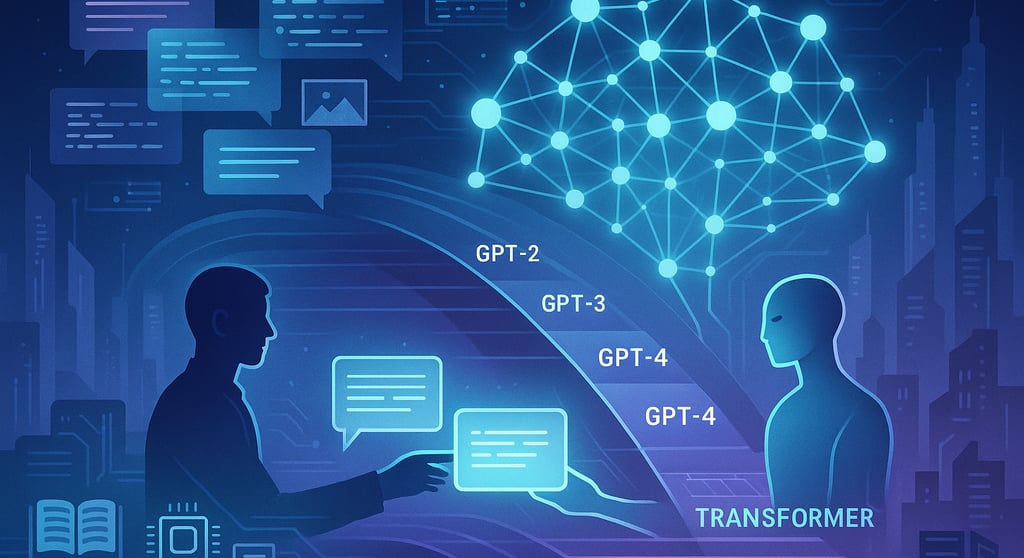Recent trends in LLMs for 2025
First chapter on recent trends in LLMs for 2025, which presents the General Context on Large Language Models (LLMs).
5/13/20253 min read


Chapter 1: Introduction and General Context about Large Language Models (LLMs)
Starting today, we will be developing a series of articles as part of a comprehensive report on the latest trends in the field of Large Language Models (LLMs) through 2025. We will structure the content into different sections addressing key aspects: technological evolution, the most relevant emerging models, innovative training and optimization techniques, as well as the main practical applications that are revolutionizing various sectors.
1.1 Definition and Fundamental Concept of LLMs
Large Language Models, commonly known by their English acronym LLMs (Large Language Models), represent an advanced category of artificial intelligence systems whose main function is the processing, understanding, and generation of human natural language. Basically, an LLM is a type of machine learning model that uses deep neural networks and extensive datasets to learn patterns, semantic and syntactic relationships in written or spoken language. With such training, these models can predict, complete, translate, and create plausible text that mimics human linguistic production.
A synthetic definition that summarizes their nature is as follows: "A large language model is an artificial intelligence algorithm that employs deep learning techniques and massive datasets to understand, interpret, and generate human language."(TechTarget) This capability is based on large-scale deep learning architectures that usually have millions or billions of parameters, thus allowing precise modeling of the complexity inherent to natural language use.
1.2 Historical Evolution and Technological Advancement
The origin of LLMs dates back to the evolution of statistical models and machine learning approaches for natural language processing (NLP), starting with n-gram based models and later with recurrent neural networks (RNNs). However, the disruptive leap came with the introduction of Transformer architectures in 2017, which optimized the parallelization of training and increased the capacity to capture extensive contexts in text.
Since then, LLMs have evolved rapidly, standing out in milestones such as GPT-2, GPT-3, and GPT-4, among others. Each iteration has dramatically increased the number of parameters and output quality, as well as incorporating new functionalities like multimodal capabilities (combined text, image, audio). This development has enabled models like GPT-4o and other recent variants not only to answer questions but also to generate creative content, programming code, and execute complex reasoning tasks.
1.3 Importance and Global Scope
The impact of LLMs transcends the purely academic field to become one of the fundamental technologies that are revolutionizing multiple industrial and social sectors. Technology, finance, health, education, and government companies are adopting these tools to improve user interaction, automate processes, and enhance decision-making through advanced language analysis.
Likewise, it is estimated that the global market for solutions based on large language models is experiencing exponential growth, driven by the demand for intelligent automation, virtual assistants, content generation, and textual data analysis. This economic and technological growth reinforces the strategic importance of understanding both the capabilities and limitations of LLMs, as well as their ethical and security implications.
1.4 Basic Operation: How Do LLMs Work?
An LLM is trained on large text corpora that may include books, articles, conversations, code, scientific data, and more. During training, the model learns to predict the next word in a sequence given a previous history — known as autoregressive language modeling — or to complete other linguistic tasks through supervised learning. This learning is based on adjusting the model’s internal parameters to minimize prediction error.
Additionally, in their operational function, LLMs employ different advanced prompting techniques, such as few-shot learning (learning with few examples) and zero-shot learning (performing tasks without specific examples), which allow them to adapt to multiple domains and requirements without the need for complete retraining. It is also common to integrate advanced reasoning capabilities (Chain-of-Thought or Tree-of-Thought) to solve complex problems beyond simple text generation.
1.5 Initial Perspectives for Later Chapters
This introductory chapter lays the foundation to examine in depth the current and future trends of LLM technology in terms of:
The latest models and their technical innovations for 2025.
New training techniques, optimization, and efficient resource use.
Integration with external sources for fact-checking and real-time data.
The growing variety of applications ranging from chatbots to code generation and machine translation.
Risks, ethical and security challenges, as well as control and evaluation metrics.
Perspectives and trends that will define the course of LLMs in the coming years.
These topics will be developed supported by recent data and specialized articles collected up to May 2025.
